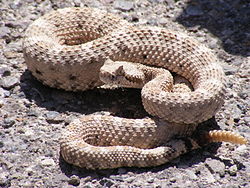Fauna of California
The fauna of the State of
Common animals that live throughout all the state include raccoons, weasels, otters, beavers, hawks, lizards, owls, coyotes, skunks, snakes, cougars, black bears, deer, squirrels and whales. As of 2013, there are 634 bird species on the California Birds Records Committee, ten of which are introduced species which are not native to the state. The California quail, the official state bird, has a breeding habit of mainly shrubby areas and open woodland. Another bird which winters in California is the American white pelican which is a large seabird, with a wingspan reaching up to 110 inches (280 cm).
Venomous spiders in California include Arizona recluse, baja recluse,
Northern California

The forests in northern parts of California have an abundant fauna, which includes for instance the
Sierra Nevada
Mammals of the Canadian zone include the snowshoe hare and several species of chipmunk. Conspicuous birds include the blue-fronted jay, hermit thrush, American dipper, and Townsend's solitaire. Birds become scarcer as one ascends to the Hudsonian zone, and the wolverine is now regarded as rare. The only bird native to the high Arctic region is the gray-crowned rosy finch, but others often visit, including the Anna's hummingbird and Clark's nutcracker.
Principal mammals of this region are also visitors from other zones; the Sierra coney and
.Lake Tahoe
In terms of volume, the largest lake in California is
Birds in the region include
Klamath Mountains
The vast forested
The area has
Big Sur
Many varieties of seabirds and waterfowl also call it home, including seagulls, cormorants, willets, sandpipers, oystercatchers, guillemots and many others. Andrew Molera State Park has over 350 different species of birds. The peregrine falcon, brown pelican, Brandt's cormorant and other seabirds are very easy to see along the coast.[14] Three amphibians are found in the area: Arboreal salamander, California newt and western toad.
Southern California


Several varieties of rattlesnakes are indigenous to the region. While only the Pacific Northwest rattler makes its home in Northern California, almost a dozen
Mojave Desert
The
Sonoran Desert
Mammals found in the deserts of the lower Sonoran zone include the
Colorado River
The
Engineering projects and river regulation have led to the extinction of four species and severe declines in the populations of 40 species. The bonytail chub, razorback sucker, Colorado pikeminnow, and humpback chub are among those considered the most at risk. All are unique to the Colorado River system and well adapted to the river's natural silty conditions and flow variations.[18]
Californian Coast

On the Californian Coast, many species of animals and plants can be found. The
Backyard wildlife
Raccoons, opossums, skunks, and foxes are common in yards, along with insects, birds, lizards, and squirrels. Bobcats may appear near the wild-land borders, along with rattlesnakes, coyotes, cougars, and bears.[19]
Channel Islands
More than 2000 species of plants and animals can be found within the
Other mammals include the harvest mouse, the
Coastal California
Along the coast of California is the
.California waters are also home to eleven species of dolphins, including the
See also
- List of amphibians of California
- List of birds of California
- List of freshwater fish in California
- List of mammals of California
- List of reptiles of California
- California Floristic Province
- List of California native plants
- Fauna of the United States
References
- ^ "Coyote Management Guidelines--UC IPM". Ipm.ucdavis.edu. Retrieved 15 October 2017.
- ^ "Flora and fauna - California". City-data.com. Retrieved 15 October 2017.
- ^ a b "California Fauna". Travelcalifornia.com. Retrieved 15 October 2017.
- ^ George, David W. "Dangerously Venomous Spiders of the United States by State". Venombyte.com. Retrieved 15 October 2017.
- ^ "Black Bear Facts". Tahoewildbears.org. Archived from the original on 9 August 2017. Retrieved 15 October 2017.
- ^ "BLM Wild Horses & Burros, Bureau of Land Management, California". Blm.gov. Retrieved 15 October 2017.
- ^ "Lake Tahoe California Wildlife, Animals - AllTrips". Alllaketahoe.com. Archived from the original on 21 September 2012. Retrieved 15 October 2017.
- ^ "The Lake Tahoe Basin - Lake Tahoe Vacation Guide". Tahoevacationguide.com. Retrieved 15 October 2017.
- ^ "Archived copy" (PDF). Archived from the original (PDF) on 2012-12-07. Retrieved 2013-04-08.
{{cite web}}: CS1 maint: archived copy as title (link) - ^ "Klamath National Forest - Home". Fs.usda.gov. Retrieved 15 October 2017.
- ^ "Klamath National Forest - Special Places". Fs.usda.gov. Retrieved 15 October 2017.
- ^ Dowd, Katie (December 26, 2019). "One eccentric socialite is to blame for California's wild pig problem". San Francisco Chronicle. Retrieved 5 February 2021.
- ^ Scutro, Andrew (November 28, 2002). "Hog Heaven". Monterey County Weekly. Retrieved 7 February 2021.
- ^ a b "Big Sur California : Vegetation and Wildlife : BigSur-Coastline.com". Bigsur-coastline.com. Retrieved 15 October 2017.
- ^ "Commonly Encountered California Lizards". Californiaherps.com. Retrieved 15 October 2017.
- ^ "Rattlesnake facts". wc.pima.edu. Retrieved 15 October 2017.
- ^ "Owls". www.desertmuseum.org. Retrieved 2019-03-23.
- ^ Colorado River Basin#CITEREFBenkeCushing2005
- ^ Sahagun, Louis (September 4, 2019). "California becomes first state to ban fur trapping after Gov. Newsom signs law". Los Angeles Times. Retrieved September 5, 2019.
- ^ a b "Places To Go - Channel Islands National Park (U.S. National Park Service)". Nps.gov. Retrieved 15 October 2017.
- ^ Sharks Indigenous to Waters off the Pacific Coast Archived 2013-10-21 at the Wayback Machine
